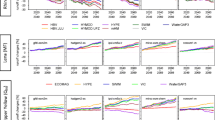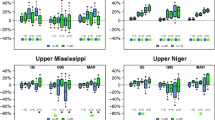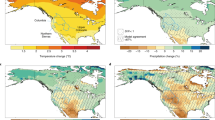Abstract
Scenario-neutral response surfaces illustrate the sensitivity of a simulated natural system, represented by a specific impact variable, to systematic perturbations of climatic parameters. This type of approach has recently been developed as an alternative to top-down approaches for the assessment of climate change impacts. A major limitation of this approach is the underrepresentation of changes in the temporal structure of the climate input data (i.e., the seasonal and day-to-day variability) since this is not altered by the perturbation. This paper presents a framework that aims to examine this limitation by perturbing both observed and projected climate data time series for a future period, which both serve as input into a hydrological model (the HBV model). The resulting multiple response surfaces are compared at a common domain, the standardized runoff response surface (SRRS). We apply this approach in a case study catchment in Norway to (i) analyze possible changes in mean and extreme runoff and (ii) quantify the influence of changes in the temporal structure represented by 17 different climate input sets using linear mixed-effect models. Results suggest that climate change induced increases in mean and peak flow runoff and only small changes in low flow. They further suggest that the effect of the different temporal structures of the climate input data considerably affects low flows and floods (at least 21% influence), while it is negligible for mean runoff.


Similar content being viewed by others
References
Bastola S, Murphy C, Sweeney J (2011) The sensitivity of fluvial flood risk in Irish catchments to the range of IPCC AR4 climate change scenarios. Sci Total Environ 409(24):5403–5415
Bergström S (1995) The HBV model. In: Singh VP (ed) Computer models of watershed hydrology. Water Resources Publications, Highlands Ranch, Colo., pp 443–476
Boé J, Terray L, Habets F, Martin E (2007) Statistical and dynamical downscaling of the Seine basin climate for hydro-meteorological studies. Int J Climatol 27(12):1643–1655
Bolker BM, Brooks ME, Clark CJ, Geange SW, Poulsen JR, Stevens MHH, White J-SS (2009) Generalized linear mixed models: a practical guide for ecology and evolution. Trends in ecology and evolution 24:3,127–3,135
Bürger G (1996) Expanded downscaling for generating local weather scenarios. Clim. Res. (7):111–128
Bürger G, Reusser D, Kneis D (2009) Early flood warnings from empirical (expanded) downscaling of the full ECMWF Ensemble Prediction System. Water Resour Res 45(10):W10443
Doherty J (2004) PEST: Model independent parameter estimation. Fifth edition of user manual. Watermark Numerical Computing, Brisbane
Fleig A, Andreassen LM, Barfod E, Haga J, Haugen LE, Hisdal H, Melvold K (2013) Norwegian Hydrological Reference Dataset for climate change studies. NVE raport, 2, Oslo, Norway
Fowler HJ, Blenkinsop S, Tebaldi C (2007) Linking climate change modelling to impacts studies: recent advances in downscaling techniques for hydrological modelling. Int J Climatol 27(12):1547–1578
Fronzek S, Carter TR, Luoto M (2011) Evaluating sources of uncertainty in modelling the impact of probabilistic climate change on sub-arctic palsa mires. Nat Hazards Earth Syst Sci 11(11):2981–2995
Gobiet A, Kotlarski S, Beniston M, Heinrich G, Rajczak J, Stoffel M (2014) 21st century climate change in the European Alps—a review. Sci Total Environ 493:1138–1151
Graham LP, Andréasson J, Carlsson B (2007) Assessing climate change impacts on hydrology from an ensemble of regional climate models, model scales and linking methods—a case study on the Lule River basin. Clim Chang 81(S1):293–307
Gudmundsson L, Bremnes JB, Haugen JE, Engen-Skaugen T (2012) Technical note: downscaling RCM precipitation to the station scale using statistical transformations—a comparison of methods. Hydrol Earth Syst Sci 16(9):3383–3390
Hirschi M, Stoeckli S, Dubrovsky M, Spirig C, Calanca P, Rotach MW, Fischer AM, Duffy B, Samietz J (2012) Downscaling climate change scenarios for apple pest and disease modeling in Switzerland. Earth Syst Dynam 3(1):33–47
IPCC (2000) Emissions scenarios. IPCC special report, Edinburgh
Lawrence D, Hisdal H (2011) Hydrological projections for floods in Norway under a future climate. NVE raport, 5
Lawrence D, Haddeland I, Langsholt E (2009) Calibration of HBV hydrological models using PEST parameter estimation. Report 1/2009. Norwegian Water Resources and Energy Administration (NVE), Oslo
van der Linden P, Mitchell JFB (2009) ENSEMBLES: climate change and its impacts: summary of research and results from the ENSEMBLES project. FritzRoz Road, Exeter, UK
Maraun D, Wetterhall F, Ireson AM, Chandler RE, Kendon EJ, Widmann M, Brienen S, Rust HW, Sauter T, Themeßl M, Venema VKC, Chun KP, Goodess CM, Jones RG, Onof C, Vrac M, Thiele-Eich I (2010) Precipitation downscaling under climate change: recent developments to bridge the gap between dynamical models and the end user. Rev. Geophys. 48(3)
Mohr M, Tveito OE (2008) Daily temperature and precipitation maps with 1 km resolution derived from Norwegian weather observations. 17th Conference on Applied Climatology, Whistler, BC, Canada, Amer Meteor Soc, 6.3. Available online at https://ams.confex.com/ams/pdfpapers/141069.pdf
Pinheiro JC, Bates DM (2004) Mixed-effects models in S and S-PLUS. Statistics and computing. Springer, New York
Prudhomme C, Wilby RL, Crooks S, Kay AL, Reynard NS (2010) Scenario-neutral approach to climate change impact studies: application to flood risk. J Hydrol 390(3–4):198–209
Räisänen J, Räty O (2013) Projections of daily mean temperature variability in the future: cross-validation tests with ENSEMBLES regional climate simulations. Clim Dyn 41(5–6):1553–1568
Räty O, Räisänen J, Ylhäisi JS (2014) Evaluation of delta change and bias correction methods for future daily precipitation: intermodel cross-validation using ENSEMBLES simulations. Clim Dyn 42(9–10):2287–2303
Saelthun NR (1996) The ‘Nordic’ HBV Model.: description and documentation of the model version developed for the project climate change and energy production. Norges Vassdrags-og Energiverk Report, 7
Steinschneider S, Wi S, Brown C (2015) The integrated effects of climate and hydrologic uncertainty on future flood risk assessments. Hydrol Process 29(12):2823–2839
Sunyer MA, Hundecha Y, Lawrence D, Madsen H, Willems P, Martinkova M, Vormoor K, Bürger G, Hanel M, Kriaučiūnienė J, Loukas A, Osuch M, Yücel I (2015) Inter-comparison of statistical downscaling methods for projection of extreme precipitation in Europe. Hydrol Earth Syst Sci 19(4):1827–1847
Teutschbein C, Seibert J (2010) Regional climate models for hydrological impact studies at the catchment scale: a review of recent modeling strategies. Geography Compass 4(7):834–860
Vormoor K, Lawrence D, Heistermann M, Bronstert A (2015) Climate change impacts on the seasonality and generation processes of floods—projections and uncertainties for catchments with mixed snowmelt/rainfall regimes. Hydrol Earth Syst Sci 19(2):913–931
Wehren B (2010) Die Hydrologie der Kander - gestern, heute, morgen: Analyse und Modellierung der Hochwasser und ihrer raumzeitlichen Dynamik. Dissertationsschrift, Bern
Wetterhall F, Graham LP, Andréasson J, Rosberg J, Yang W (2011) Using ensemble climate projections to assess probabilistic hydrological change in the Nordic region. Nat Hazards Earth Syst Sci 11(8):2295–2306
Wilby RL, Dawson CW, Murphy C, O’Connor P, Hawkins E (2014) The statistical DownScaling model-decision centric (SDSM-DC): conceptual basis and applications. Clim Res 61(3):259–276
Winter B (2013) Linear models and linear mixed effects models in R with linguistic applications. arXiv:1308.5499. [http://arxiv.org/pdf/1308.5499.pdf]
Acknowledgements
The first author acknowledges the Helmholtz graduate school GeoSim for funding the PhD studentship. The Norwegian Water Resources and Energy Directorate (NVE) is thanked for providing the hydrological model code and the runoff and climate observation data. The regional climate model simulations stem from the EU FP6 project ENSEMBLES, whose support is gratefully acknowledged. All statistical analyses and visualizations (except S1) were performed within the R software environment (www-r-project.org). Critical comments by three anonymous reviewers on an earlier version of this manuscript helped to improve this paper.
Author information
Authors and Affiliations
Corresponding author
Electronic supplementary material
.
ESM 1
(PDF 1319 kb)
Rights and permissions
About this article
Cite this article
Vormoor, K., Rössler, O., Bürger, G. et al. When timing matters-considering changing temporal structures in runoff response surfaces. Climatic Change 142, 213–226 (2017). https://doi.org/10.1007/s10584-017-1940-1
Received:
Accepted:
Published:
Issue Date:
DOI: https://doi.org/10.1007/s10584-017-1940-1




